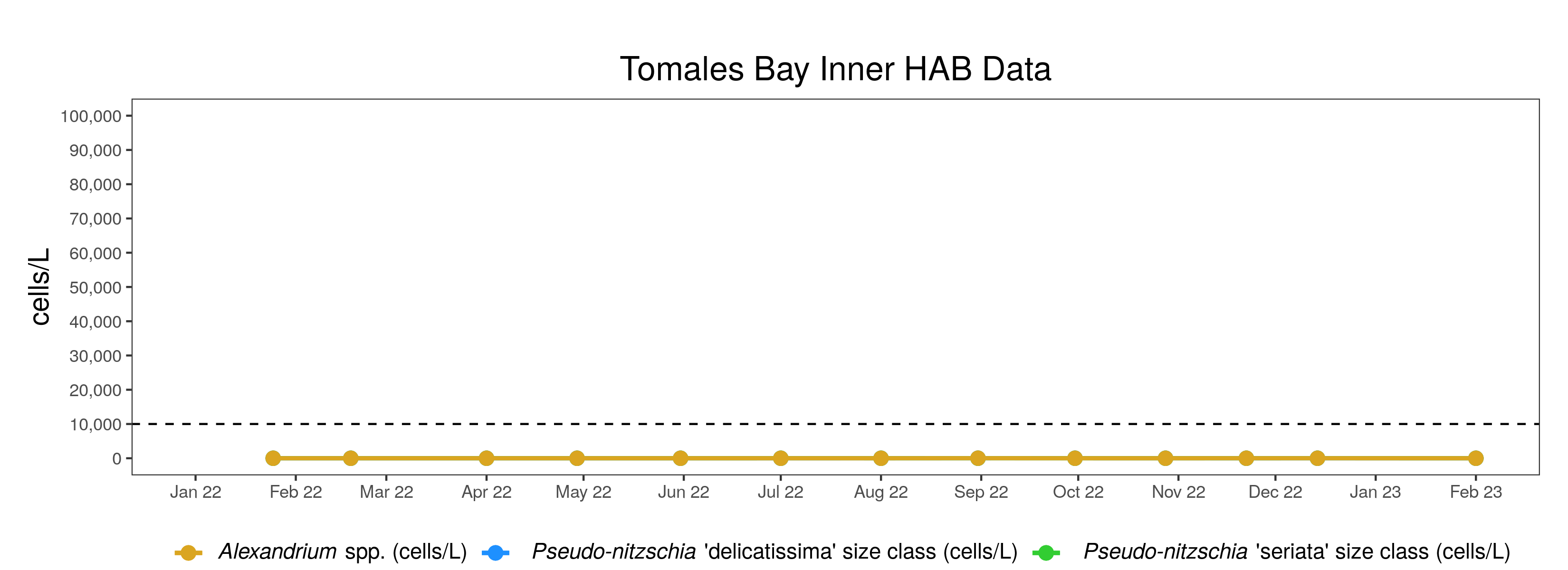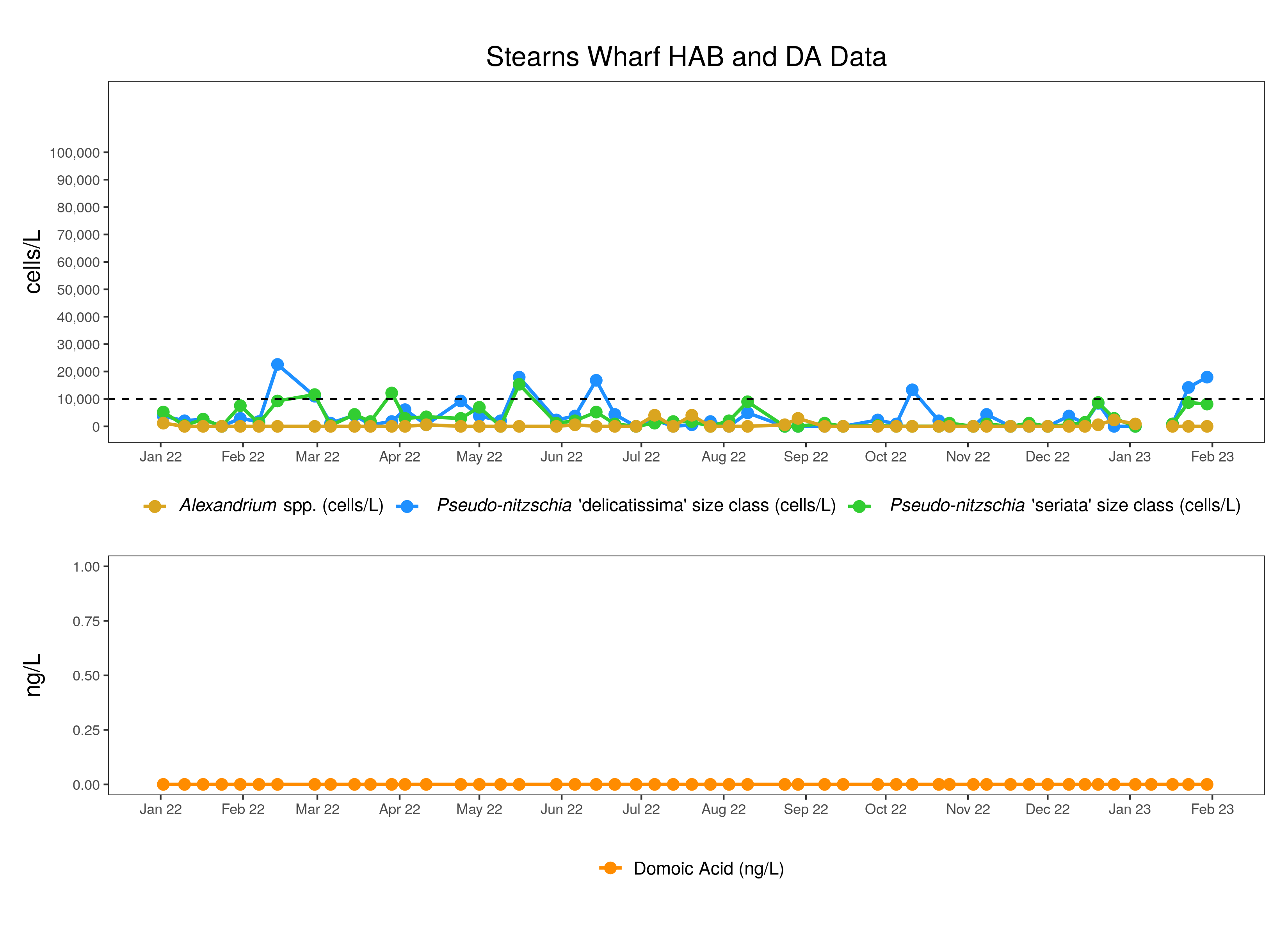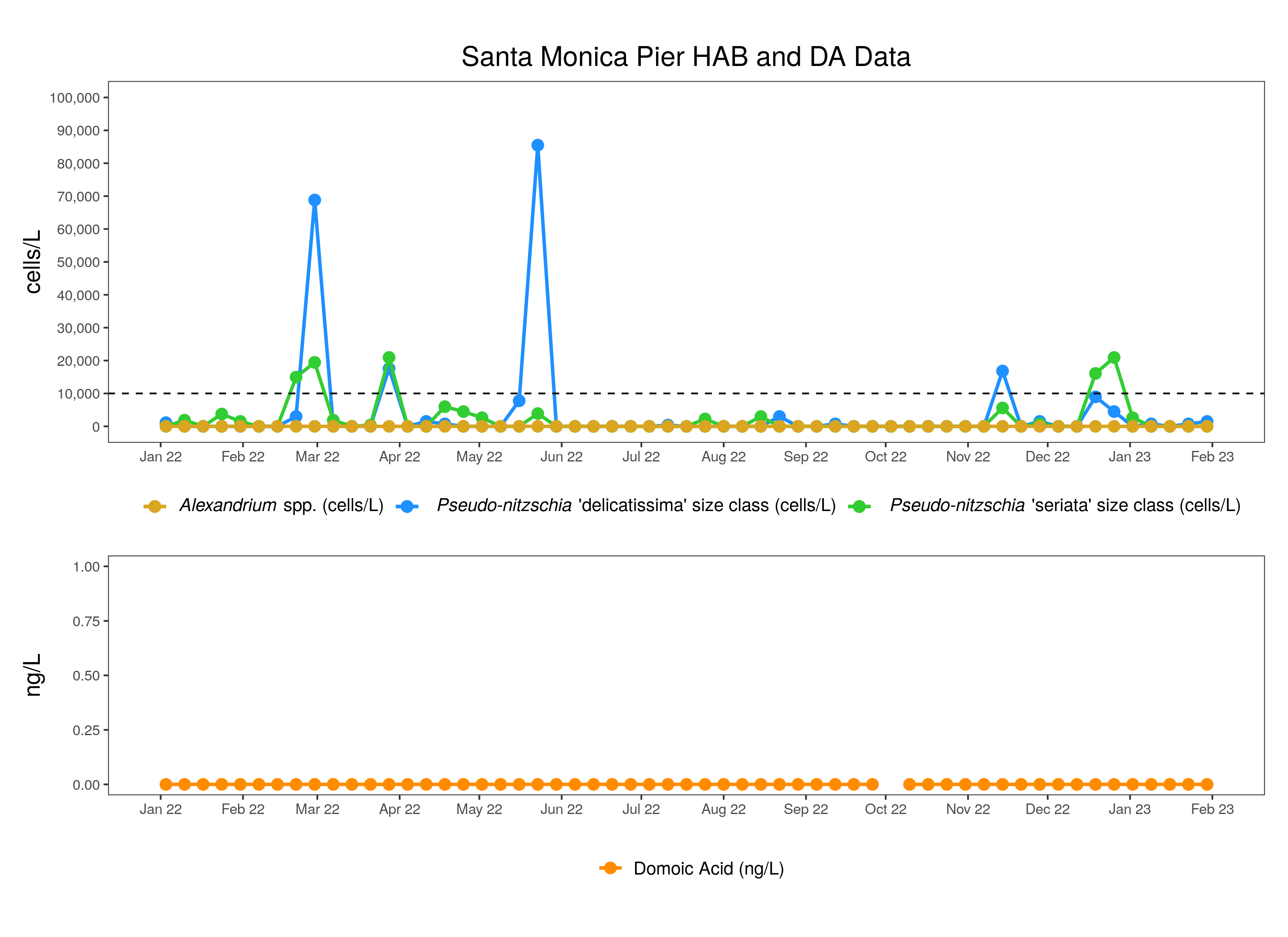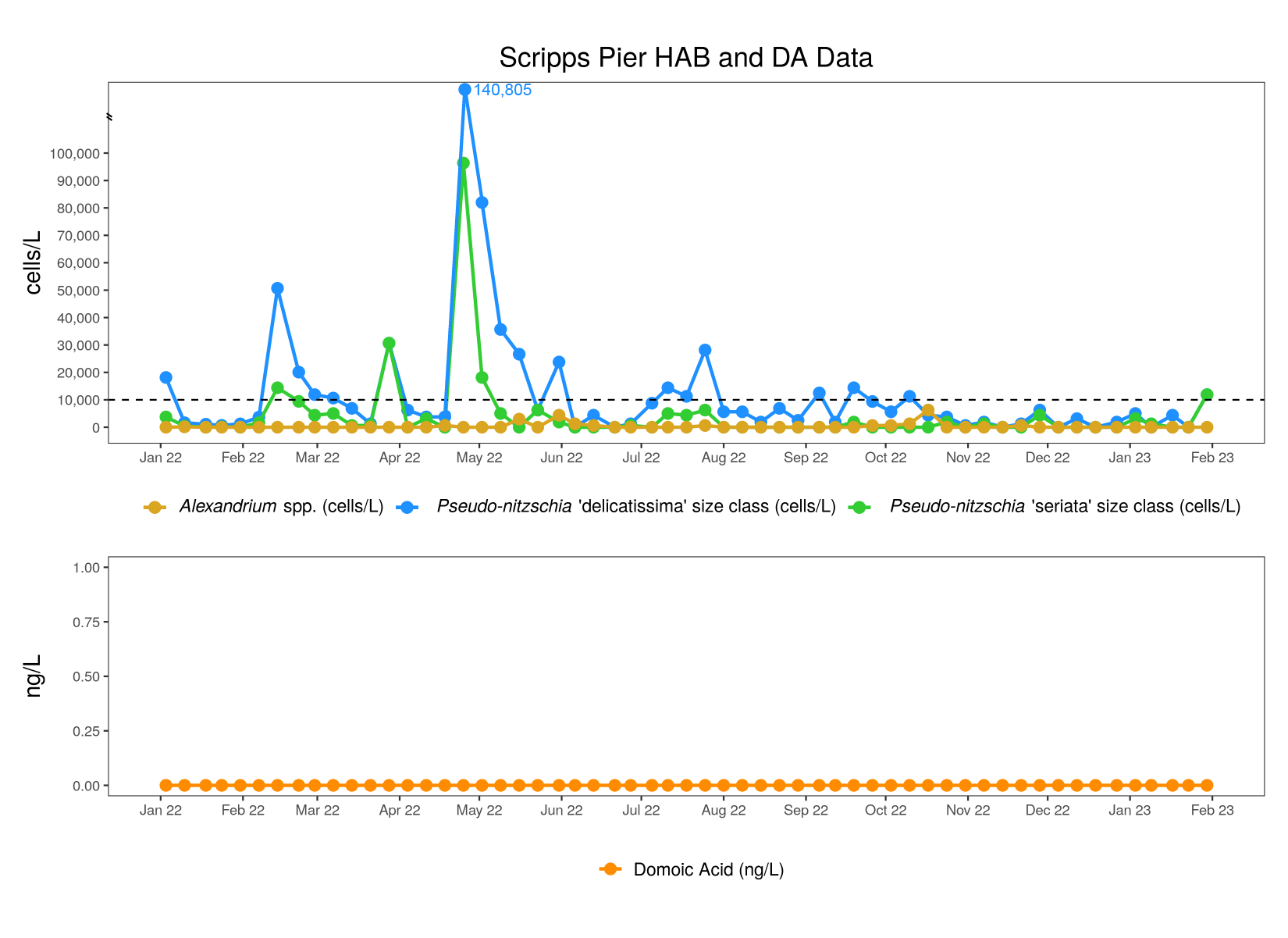JANUARY HIGHLIGHTS
*note: for the full suite of HAB taxa sampled weekly, see the SCCOOS and CeNCOOS HABMAP database and the Imaging FlowCytobot Dashboard.
Pseudo-nitzschia -
* Important update to C-HARM in this bulletin. C-HARM version 3 is now operational at NOAA CoastWatch. Major changes include: new operational circulation model (WCOFS) for currents, salinity, and temperature and VIIRS ocean color products in place of MODIS Aqua. WCOFS is a 4DVAR data assimilative model run at NOAA Coast Survey Development Lab (CSDL). NOTE: There are serious issues with WCOFS salinity accuracy that have notable consequences for the Particulate Domoic Acid predictions; we will address the impact this has on pDA accuracy in these bulletins.
-
- C-HARM tells us where conditions are suitable for species of the diatom Pseudo-nitzschia spp. (all size classes) to grow well and where they might be more likely to produce the deadly neurotoxin, domoic acid (DA). Three independent models are run daily to produce nowcasts and three-day forecasts of the probability of a bloom, the probability of a DA event for particulate DA only, and the probability of a DA event for the cellular portion of DA only. Here, in the bulletin, we summarize nowcasts for the month.
- C-HARM predictions for Pseudo-nitzschia spp. blooms in January contain some pixelation from VIIRS. Bloom potential is very high throughout the month, covering the entire coastline, sometimes extending very far offshore. This suggests a high rate of false positives given that we know blooms were not so pervasive in January, but this also corroborates something we've seen for a while in the California Current, which is that conditions are fairly regularly conducive to supporting Pseudo-nitzschia populations in most coastal zones.
- HABMAP weekly pier sampling indicated moderate to low Pseudo-nitzschia spp. activity in the nearshore environment, in keeping with recent trends at the piers. However, bloom levels were reached at two locations in January: Stearns Wharf at the end of January and Scripps Pier, also in late January, the latter being the more toxigenic size class, P. "seriata."
- Pseudo-nitzschia activity from CDPH coastal sampling in January detected the more toxigenic size class, Pseudo-nitzschia 'seriata,' as 'Common' at Scripps Pier in early January but "Rare" at most other sites sampled.
- A selection of CA Imaging FlowCytobot (IFCB) Network images from the Bodega Marine Laboratory in northern California and from an offshore buoy at Del Mar (San Diego) in January illustrates some interesting latitudinal gradients from north to south. Large centric diatoms, the large dinoflagellate genus, Prorocentrum, and small particles dominate the Bodega samples, while Tripos (formerly Ceratium) and Lingulodinium polyedra are most abundant at the Del Mar site in southern California.
- C-HARM probabilities for particulate domoic acid (pDA) and cellular domoic acid (cDA) in January suggest highest potential for toxic events in central California as well as a large part of the Southern California Bight. The intensity is much higher for pDA, which we think is biased by the overestimated salinity fields produced by WCOFS. If we look more exclusively at cDA, which does not rely on the salinity prediction, we see similar overall patterns to pDA, albeit with lower probabilities throughout the Bight for much of the month and lower probabilities along the coastline in central CA. Another stark difference between the cDA and pDA is the high pDA risk hugging the coastline in northern California for much of the month.
- Only one animal was reported stranded from potential DA toxicosis in January (La Jolla, by SeaWorld). This stranding directly aligns with the CDPH observation of "Common" levels of the more toxigenic Pseudo-nitzschia 'seriata' size class on January 3 in La Jolla. It more generally aligns with the predicted cDA and pDA risk for the region but is less consistent with the Scripps Pier HABMAP results, which captured bloom levels of Pseudo-nitzschia 'seriata' at the end of January. Interestingly, DA was not detected at any of the HABMAP sites in January, including at Scripps Pier in La Jolla. This is an expected result for the time of year, however, this is not consistent with the stranding record in La Jolla.
- CDPH lifted an advisory on January 9 for mussels, scallops, and most types of clams in Humboldt County due to PSP and ASP. However, the advisory related to sport-harvested razor clams from Humboldt and Del Norte counties remains in effect due to ASP risk. Given the low depuration (detox) rates of razor clams, DA levels in razor clams are usually more a reflection of long-term exposure to DA rather than real-time or recent bloom conditions. However, since this same advisory was lifted in June and then reinstated in November of this year, there has likely been persistent, if low-level, production of DA in the North Coast region. Note that the annual quarantine on consuming recreational mussels was lifted at the end of October, except for Humboldt, San Mateo, Monterey, and San Luis Obispo.
Alexandrium -
- CDPH detected 'Rare' levels of Alexandrium spp. in January at Goleta Pier, consistent with the HABMAP record of Alexandrium at Stearns Wharf. In line with that, the Paralytic Shellfish Poisoning (PSP) advisory was lifted on January 9 for mussels, scallops, and most types of clams in Humboldt County.
Summary written by Clarissa Anderson on 4 April 2023
Note that data for some stations are not shown because they are not yet recorded in the public HABMAP archive.
Differentiating Pseudo-nitzschia species by light microscopy is difficult. For this reason, Pseudo-nitzschia "seriata" does not refer to an actual species but rather the larger size class of Pseudo-nitzschia, which is generally a more toxigenic group of species. Alternatively, Pseudo-nitzschia "delicatissima" refers to the smaller size class that is generally non-toxigenic. The dashed line on the plots demarcates the 10,000 cells/L "bloom" threshold designated here for Pseudo-nitzschia populations only.
More information and data visualizations on the statewide HAB network and forecasting system can be found on the California HABMAP website and on the SCCOOS Harmful Algal Bloom page.
Six water sample was collected at the Bodega Marine Lab shore station in January. Pseudo-nitzschia "delicatissima" was detected once on January 25. Pseudo-nitzschia "seriata" and Alexandrium spp. were not detected. Domoic acid results are pending.
The Bodega Marine Lab shore station is supported by CeNCOOS PI John Largier.
One water sample was collected at the Bodega Marine Lab Buoy station in January. Pseudo-nitzschia "delicatissima" and Pseudo-nitzschia "seriata" were detected below the threshold. Alexandrium spp. were not detected. Domoic acid results are pending.
The Bodega Marine Lab Buoy shore station is supported by CeNCOOS PI John Largier.
Three water samples were collected at Santa Cruz Wharf in January. Molecular probes for toxigenic Pseudo-nitzschia in the "seriata" class are conducted for this site, and was detected once on January 11, below the bloom threshold. Alexandrium spp. were also detected on January 11. Domoic acid was not detected.
The Santa Cruz Wharf shore station is supported by CeNCOOS PI Raphael Kudela at UCSC
Five water samples were collected at Cal Poly Pier in January. Pseudo-nitzschia "delicatissima" was detected once on January 30, below the bloom threshold. Pseudo-nitzschia "seriata", Alexandrium spp. and domoic acid were not detected.
Cal Poly Pier shore station is supported by SCCOOS and PI Ally Pasulka at Cal Poly.
Five water samples were collected at Stearns Wharf in January, though the sample from January 9 is pending analysis. Pseudo-nitzschia "delicatissima" and Pseudo-nitzschia "seriata" were detected three times (January 17, 23, 30) with "delicatissima" above the bloom threshold for the last two samples. Alexandrium spp. were detected on January 3. Domoic acid was not detected.
Stearns Wharf is supported by SCCOOS and PIs Mark Brzezinski and Libe Washburn at UCSB.
Five water samples were collected at Santa Monica Pier in January. Pseudo-nitzschia "delicatissima" was detected on three occasions (January 9, 23, 30), all below the bloom threshold. Pseudo-nitzschia "seriata" was detected once (January 1), also below the threshold. Alexandrium spp. and domoic acid were not detected.
The Santa Monica Pier shore station is supported by SCCOOS and PI Rebecca Shipe at UCLA.
Five water samples were collected at Newport Beach Pier in January. Pseudo-nitzschia "delicatissima" was detected on January 23 and 30, with the first above the bloom threshold. Pseudo-nitzschia "seriata" was detected on January 23 below the threshold. Alexandrium spp. and domoic acid were not detected.
Newport Beach Pier is supported by SCCOOS and PI David Caron at USC.
Five water samples were collected at Scripps Pier in January. Pseudo-nitzschia "delicatissima" was detected on three occasions (January 3, 17, 30) with the last sample above the bloom threshold. Pseudo-nitzschia "seriata" was detected three times (January 3, 9, 30), with the last sample also above the threshold. Alexandrium spp. and domoic acid were not detected.
Scripps Pier is supported by SCCOOS and PIs Melissa Carter and Clarissa Anderson at UCSD.
CDPH observations for Pseudo-nitzschia "seriata" and Alexandrium spp.
View the interactive map and data table of California Department of Public Health (CDPH) data from January 2019 to present, developed by SCCOOS, below. Or, view CDPH Toxic Phytoplankton Observations Map with layers of Pseudo-nitzschia and Alexandrium spp. as well as other phytoplankton species observations (in the pop-up windows).
Data are provided by the Environmental Management Branch of the CDPH. Please note, starting in July 2019, CDPH moved to only reporting Pseudo-nitzschia of the seriata complex and not all Pseudo-nitzschia spp. as previously provided.
Please email CDPH at Susan.Paulukonis@cdph.ca.gov for any potential marine HAB-related illness in humans.
From January 1-31 2023, water samples were collected by volunteers and sent to the California Department of Public Health (CDPH) for analysis.
Pseudo-nitzchia "seriata" group was detected in 12 of the 67 samples:
Pseudo-nitzschia "seriata" was detected at "Common" density levels once:
- 2023-01-03 10% La Jolla, Scripps Pier
Pseudo-nitzschia "seriata" was not detected at "Present" density levels.
Pseudo-nitzschia "seriata" was detected at "Rare" density levels on 11 occasions:
- 2023-01-03 0.5% Tomales Bay, Lease #M430-15
- 2023-01-04 0.5% Goleta Pier
- 2023-01-08 0.5% San Francisco, Presidio Pier
- 2023-01-09 0.5% Tomales Bay, Lease #M430-15
- 2023-01-13 0.5% Bolsa Chica
- 2023-01-12 0.5% San Clemente Pier
- 2023-01-23 0.5% Humboldt Bay, Indian Is. Ch.
- 2023-01-30 0.5% Drakes Bay, Chimney Rock LBS
- 2023-01-31 0.5% San Clemente Pier
- 2023-01-29 0.5% Pacific Beach Pier
- 2023-01-28 0.5% Monterey Bay, Commercial Wharf
Alexandrium spp. were detected in 1 of the 67 samples:
Alexandrium spp. were not detected at "Common" density levels.
Alexandrium spp. were not detected at "Present" density levels.
Alexandrium spp. were detected at "Rare" density levels once:
- 2023-01-04 0.5% Goleta Pier
CDPH and OEHHA Health Advisories
January 9. The California Department of Public Health (CDPH) has lifted the shellfish safety notification today related to sport-harvested mussels, scallops, and most types of clams in Humboldt County. An advisory for razor clams in Humboldt County remains in effect.
December 12. The California Department of Public Health (CDPH) has lifted the shellfish safety notifications today related to sport-harvested mussels, scallops, and clams in San Mateo, Monterey, and San Luis Obispo counties.
October 31. The California Department of Public Health (CDPH) announced the statewide annual quarantine on mussels taken by sport harvesters from California’s ocean waters ends at midnight on Monday, October 31, 2022, for all coastal counties except Humboldt, San Mateo, Monterey, and San Luis Obispo.
For the latest closures and updates, please visit the CDPH Health Advisories page as a central location of information related to CDPH health advisories. Also available is a map showing the current CDPH Recreational Bivalve Shellfish Advisories (see below).
The HAB-related illness workgroup has developed a new webpage for marine HAB-related illness tracking work (https://oehha.ca.gov/fish/general-info/marine-harmful-algal-bloom-hab-related-illness-tracking).
A network of Imaging FlowCytobots (IFCBs) continuously photographs particles, such as plankton, in the water. Using machine learning, plankton species can be automatically identified. This will help improve the ability to detect and respond to Harmful Algal Blooms, including the ability to assess conditions that may lead to toxin production or blooms of toxin-producing algae.
Additional images and data are available on the IFCB dashboard.
A mosaic of images from early January.
Domoic acid (DA) is a potent neurotoxin produced by some diatom species of the genus Pseudo-nitzschia. Species exposed to DA can result in seizures, epilepsy, cardiomyopathy, and death depending upon the ingested dose. DA toxicosis commonly occurs in California Sea Lions (Zalophus californianus), presumably due to a combination of foraging behavior and seasonal movements. The Marine Mammal Center (TMMC), Channel Islands Marine Wildlife Institute (CIMWI), California Wildlife Center (CWC), Marine Mammal Care Center Los Angeles (MMCC-LA), Marine Animal Rescue (MAR), the Pacific Marine Mammal Center (PMMC), SeaWorld, and Southwest Fisheries Science Center (SWFSC) act like an emergency room by working to rescue and rehabilitate sick and injured marine mammals, seabirds, and sea turtles.
TMMC, MMCCLA, CWC, PMMC and CIMWI did not record any strandings due to suspected domoic acid in January 2023. Results from SWFSC are pending.
January strandings due to suspected DA toxicosis occurred in the following counties:
- San Diego (SeaWorld)
- January 8 - Adult, female, California Sea Lion






















